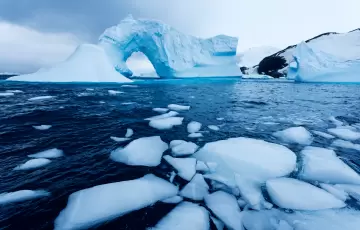Sudden Stratospheric Warming
Q. What is Sudden Stratospheric Warming? Illustrate its impact on atmospheric phenomena.
An unusual warming event known as Sudden Stratospheric Warming (SSW) has been observed over Antarctica which is also found to be linked with an ozone hole shrinking over the pole. The term sudden stratospheric warming refers to what is observed in the stratosphere; – a rapid warming (up to about 50-°C in just a couple of days), between 10 km and 50 km above the earth’s surface. This is so high that we don’t feel the ‘warming’ ourselves. However, usually a few weeks later, we can start to see knock-on effects on the jet stream, which in turn affects our lower down (in the troposphere).
The stratospheric sudden warming doesn’t happen every year, and it doesn’t always affect our weather when it does.
Origin/Cause of Sudden Stratospheric Warming
Every winter, westerly winds – often up to 200 kilometre per hour (120 miles per hour) – develop in the stratosphere high above the South Pole and circle the polar region.
The winds develop as a result of the difference in temperature over the pole (where there is no sunlight) and the Southern Ocean (where the sun still shines).
As the sun shifts southward during the spring of the southern hemisphere, the polar region starts to warm. This warming auses the stratospheric polar vortex and associated westerly winds to gradually weaken over the period of a few months. (A stratospheric polar vortex is an upper-level low-pressure area lying near one of the Earth’s poles)
Waves of air from the lower atmosphere (from large weather systems or flow over mountains) warm the stratosphere above the South Pole, and weaken or mix the high-speed westerly winds. Very rarely, if the waves are strong enough they can rapidly break down the polar vortex, actually reversing the direction of the winds so they become easterly. This is called “sudden stratospheric warming.”
Apart from warming the Antarctic region, the most notable effect will be a shift of the Southern Ocean westerly winds towards the Equator and thus impacting other regions as well.
The formation of SSWs tend to have larger amplitudes in the Northern Hemisphere compared with the Southern Hemisphere.
This is partly because of differences in the distributions of mountains, land, and sea in the hemispheres.
Tropospheric planetary waves are fed by temperature contrasts between land and ocean as well as mountains that channel wind flow, factors more prevalent in the north.
Thus, SSWs occur primarily in the Northern Hemisphere, although a single strong SSW in the Southern Hemisphere was observed in September 2002.
Impact on atmospheric phenomena
On Ozone layer
- As per NASA and US National Oceanic and Atmospheric Administration (NOAA) reports, the ozone hole over the Antarctic has been the smallest observed since 1982 during the last two months.
- The Antarctic ozone hole forms during the Southern Hemisphere’s late winter as the returning Sun’s rays start ozone-depleting reactions.
- These reactions involve chemically active forms of chlorine and bromine derived from man- made compounds and occur on the surfaces of cloud particles that form in cold stratospheric layers.
- In warmer temperatures fewer polar stratospheric clouds form and they don’t persist as long, thus limiting the ozone-depletion process.
- It is indeed a positive development as it will preserve the ozone layer that shields the planet from harmful ultraviolet radiation. However, it is mainly due to warmer stratospheric temperatures and not a sign of ozone recovery due to global regular Warmer stratospheric temperatures.
- The ozone layer over the Antarctic is expected to recover by 2070 as compounds used as coolants, called chlorofluorocarbons, decline.
On weather
- The stratospheric sudden warming can sometimes cause the jet stream to ‘snake’ more, and this tends to create a large area of blocking high pressure.
- Typically, this will form over the North Atlantic and Scandinavia. This means that northern Europe, including the UK is likely to get a long spell of dry, cold weather, whereas southern Europe will tend to be more mild, wet and windy.
- On the boundary of these areas, cold easterly winds develop and in some cases the drop in temperatures leads to snow.
- This can trigger hot, dry winds across Australia over the next three months, impact rainfall and worsen droughts in theinent.
- Dry and windy conditions are likely to increase the fire threat in a number of regions, with 15 fires already burning in the south-east region.
On other atmospheric phenomena
- High above Earth’s surface, air temperatures occasionally increase suddenly, producing widespread effects on weather, air chemistry, and telecommunications.
- Recent research has conclusively shown the existence of a strong connection between SSWs and extensive changes throughout Earth’s atmosphere.
- These changes can affect atmospheric chemistry, temperatures, winds, neutral (non-ionized particles) and electron densities, and electric fields.
- They extend from the surface to the thermosphere and across both hemispheres.
- The implications extend not only to weather forecasting here on the surface but also to greater understanding of chemical processes in the atmosphere.
- For example, adverse effects on satellite navigation systems (e.g., GPS) and telecommunications, and possibly even the study of atmospheres on other planets.
- Since understanding atmospheric phenomena is very crucial to understanding the changing climate, SSW becomes an important area of study. Such thermodynamic changes and atmospheric circulations, if properly understood, can help us lead mitigation efforts against climate change.







